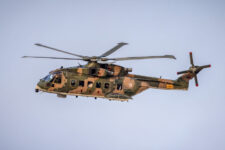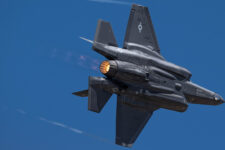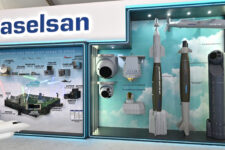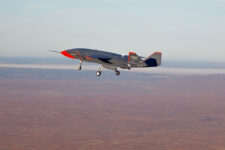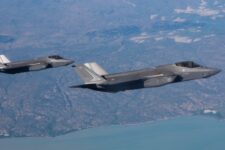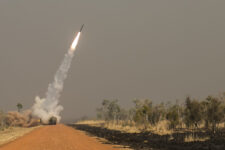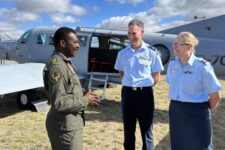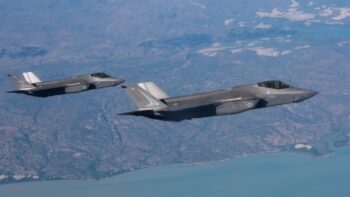
A Honeywell office in Atlanta, Georgia, US, on Wednesday, Oct. 25, 2023. (Elijah Nouvelage/Bloomberg via Getty Images)
FARNBOROUGH 2024 — Leadership at Honeywell Aerospace views the burgeoning drone market as a major growth opportunity, with the firm pitching products for the emerging market ranging from key subsystems to engines, according to a company executive.
“There are a lot of unmanned systems, that’s where we’re seeing a lot of growth,” Matt Milas, Honeywell’s Defense and Space president, said in a Tuesday interview. “So we’re definitely moving in the direction of unmanned solutions for defense applications.”
Honeywell, Milas said, is leveraging commercial technologies developed for advanced air mobility aircraft, largely consisting of hybrid- and fully-electric vertical takeoff and landing (eVTOL) platforms, and adapting it for loyal wingmen drones such as the Air Force’s Collaborative Combat Aircraft (CCA) program. The two sets of platforms can share several technologies, Milas said, such as vapor cooling systems, compact avionics and satellite communications.
“Those [eVTOL aircraft], while not autonomous, they have a lot of the same look and feel and capability and the future potential of becoming autonomous,” he said.
The company is working with the Air Force’s two CCA vendors on contract — General Atomics and Anduril, with their respective drone pitches known as Gambit and Fury — as well as “other providers,” Milas said, though he added he can’t offer specifics. Honeywell is targeting a variety of roles, he said, such as logistics, refueling and direct combat.
“So we’re looking at the broader applications of the different payloads and different missions. But what are the core things like the environmental controls, the power generation, and even engines,” he said.
Milas highlighted the company’s F124 turbofan engine that offers 6,000 pounds of thrust, a powerplant toward the higher end of a thrust range previously identified by an Air Force request for information from industry. Milas said the company’s propulsion “sweet spot” is the mid- to high-end engine market, though he left options open as CCA requirements, and use cases, shake out.
“So we’re looking at what’s going to be the evolution of CCAs, and you’ll have some high-end, some low-end, some mid-end, what types of propulsion, power, cooling, avionics, etc. And in the future, hopefully, once the CAES deal closes, we’ll have some electronic warfare, electromagnetic defense and other RF [radio frequency] solutions that will be available for a small form factor, not quite attributable, but more affordable types of solutions,” he said.
A range of different drone-focused engine pitches were on display at the Farnborough air show this past week, with propulsion companies in particular each vying for a niche of the rapidly developing drone market. GE Aerospace and Kratos, for example, unveiled a partnership for a new “family” of cheaper engines that could power systems ranging from loitering munitions to drones. Pratt & Whitney too provided some details of its own approach, touting additive manufacturing that can be adapted to existing designs so that engines can be more cheaply and quickly mass produced.


